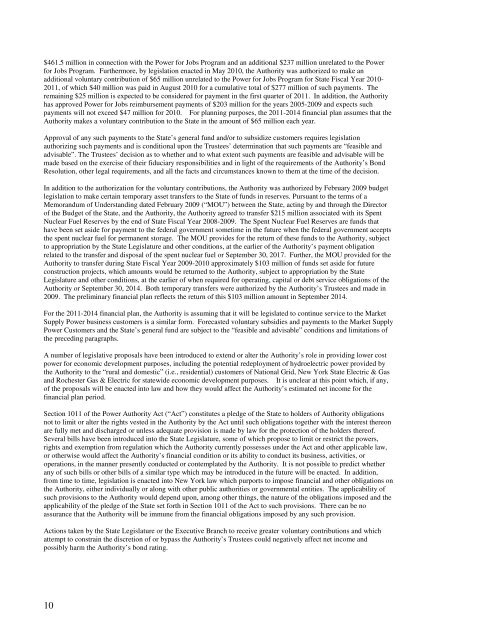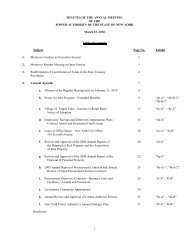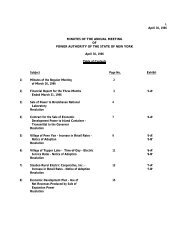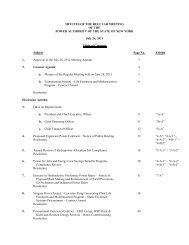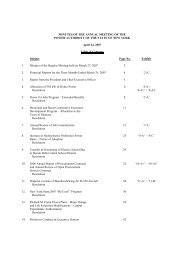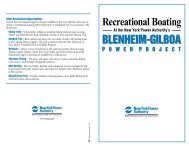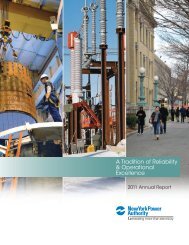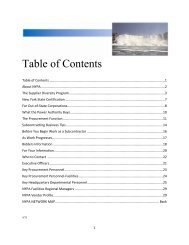PDF - New York Power Authority
PDF - New York Power Authority
PDF - New York Power Authority
You also want an ePaper? Increase the reach of your titles
YUMPU automatically turns print PDFs into web optimized ePapers that Google loves.
$461.5 million in connection with the <strong>Power</strong> for Jobs Program and an additional $237 million unrelated to the <strong>Power</strong><br />
for Jobs Program. Furthermore, by legislation enacted in May 2010, the <strong>Authority</strong> was authorized to make an<br />
additional voluntary contribution of $65 million unrelated to the <strong>Power</strong> for Jobs Program for State Fiscal Year 2010-<br />
2011, of which $40 million was paid in August 2010 for a cumulative total of $277 million of such payments. The<br />
remaining $25 million is expected to be considered for payment in the first quarter of 2011. In addition, the <strong>Authority</strong><br />
has approved <strong>Power</strong> for Jobs reimbursement payments of $203 million for the years 2005-2009 and expects such<br />
payments will not exceed $47 million for 2010. For planning purposes, the 2011-2014 financial plan assumes that the<br />
<strong>Authority</strong> makes a voluntary contribution to the State in the amount of $65 million each year.<br />
Approval of any such payments to the State’s general fund and/or to subsidize customers requires legislation<br />
authorizing such payments and is conditional upon the Trustees’ determination that such payments are “feasible and<br />
advisable”. The Trustees’ decision as to whether and to what extent such payments are feasible and advisable will be<br />
made based on the exercise of their fiduciary responsibilities and in light of the requirements of the <strong>Authority</strong>’s Bond<br />
Resolution, other legal requirements, and all the facts and circumstances known to them at the time of the decision.<br />
In addition to the authorization for the voluntary contributions, the <strong>Authority</strong> was authorized by February 2009 budget<br />
legislation to make certain temporary asset transfers to the State of funds in reserves. Pursuant to the terms of a<br />
Memorandum of Understanding dated February 2009 (“MOU”) between the State, acting by and through the Director<br />
of the Budget of the State, and the <strong>Authority</strong>, the <strong>Authority</strong> agreed to transfer $215 million associated with its Spent<br />
Nuclear Fuel Reserves by the end of State Fiscal Year 2008-2009. The Spent Nuclear Fuel Reserves are funds that<br />
have been set aside for payment to the federal government sometime in the future when the federal government accepts<br />
the spent nuclear fuel for permanent storage. The MOU provides for the return of these funds to the <strong>Authority</strong>, subject<br />
to appropriation by the State Legislature and other conditions, at the earlier of the <strong>Authority</strong>’s payment obligation<br />
related to the transfer and disposal of the spent nuclear fuel or September 30, 2017. Further, the MOU provided for the<br />
<strong>Authority</strong> to transfer during State Fiscal Year 2009-2010 approximately $103 million of funds set aside for future<br />
construction projects, which amounts would be returned to the <strong>Authority</strong>, subject to appropriation by the State<br />
Legislature and other conditions, at the earlier of when required for operating, capital or debt service obligations of the<br />
<strong>Authority</strong> or September 30, 2014. Both temporary transfers were authorized by the <strong>Authority</strong>’s Trustees and made in<br />
2009. The preliminary financial plan reflects the return of this $103 million amount in September 2014.<br />
For the 2011-2014 financial plan, the <strong>Authority</strong> is assuming that it will be legislated to continue service to the Market<br />
Supply <strong>Power</strong> business customers is a similar form. Forecasted voluntary subsidies and payments to the Market Supply<br />
<strong>Power</strong> Customers and the State’s general fund are subject to the “feasible and advisable” conditions and limitations of<br />
the preceding paragraphs.<br />
A number of legislative proposals have been introduced to extend or alter the <strong>Authority</strong>’s role in providing lower cost<br />
power for economic development purposes, including the potential redeployment of hydroelectric power provided by<br />
the <strong>Authority</strong> to the “rural and domestic” (i.e., residential) customers of National Grid, <strong>New</strong> <strong>York</strong> State Electric & Gas<br />
and Rochester Gas & Electric for statewide economic development purposes. It is unclear at this point which, if any,<br />
of the proposals will be enacted into law and how they would affect the <strong>Authority</strong>’s estimated net income for the<br />
financial plan period.<br />
Section 1011 of the <strong>Power</strong> <strong>Authority</strong> Act (“Act”) constitutes a pledge of the State to holders of <strong>Authority</strong> obligations<br />
not to limit or alter the rights vested in the <strong>Authority</strong> by the Act until such obligations together with the interest thereon<br />
are fully met and discharged or unless adequate provision is made by law for the protection of the holders thereof.<br />
Several bills have been introduced into the State Legislature, some of which propose to limit or restrict the powers,<br />
rights and exemption from regulation which the <strong>Authority</strong> currently possesses under the Act and other applicable law,<br />
or otherwise would affect the <strong>Authority</strong>’s financial condition or its ability to conduct its business, activities, or<br />
operations, in the manner presently conducted or contemplated by the <strong>Authority</strong>. It is not possible to predict whether<br />
any of such bills or other bills of a similar type which may be introduced in the future will be enacted. In addition,<br />
from time to time, legislation is enacted into <strong>New</strong> <strong>York</strong> law which purports to impose financial and other obligations on<br />
the <strong>Authority</strong>, either individually or along with other public authorities or governmental entities. The applicability of<br />
such provisions to the <strong>Authority</strong> would depend upon, among other things, the nature of the obligations imposed and the<br />
applicability of the pledge of the State set forth in Section 1011 of the Act to such provisions. There can be no<br />
assurance that the <strong>Authority</strong> will be immune from the financial obligations imposed by any such provision.<br />
Actions taken by the State Legislature or the Executive Branch to receive greater voluntary contributions and which<br />
attempt to constrain the discretion of or bypass the <strong>Authority</strong>’s Trustees could negatively affect net income and<br />
possibly harm the <strong>Authority</strong>’s bond rating.<br />
10


